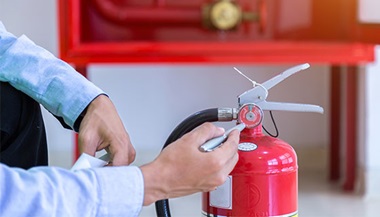'Tis the Season for Holiday Cooking Safety
Featured Expert
Long lines at the grocery store, package deliveries piling up on doorsteps — yes, it’s beginning to look a lot like the holidays.
All the hectic preparations may prove distracting when it comes to safety in the kitchen, leading to accidental burns or scalds. According to the National Fire Protection Association, winter holidays are peak days for home cooking fires.
With the end of the year approaching and the holiday festivities drawing near, it is is a good time for families to review their fire safety plan.
The two most important parts of such a plan are knowing the best route to evacuate your house or dwelling and knowing the location of your fire extinguisher.
Holiday Cooking Safety
Whether you’re hosting a festive get-together or just bringing along a dish, prevent kitchen fires and cook safely with these tips in mind:
- Keep flammable items away from the stovetop, including oven mitts, potholders, food packaging and dishtowels. Avoid wearing loose clothing, which could catch fire on burners.
- Do not leave cooking unattended. When using the stovetop, stay in the kitchen so you can keep an eye on the food. If you have something in the oven, check on it frequently; set a timer as a reminder.
- Keep the floor clear of any tripping hazards, such as bags or toys. Pets should be kept in another room where they won’t risk getting underfoot.
- Stay alert while cooking on the stove. If you’re tired or have consumed alcohol, let someone else take over.
- Exercise caution when handling hot liquids and foods, as steam or splashes can cause serious burns, as well as the trays, pans and serving dishes they are in.
When it is time to set the table, place hot liquids and foods in the center of the table, where they are less likely to be knocked over.
Kids in the Kitchen
The kitchen can be a risky place for children, especially amid the chaos of holiday preparations. From hot foods and liquids to knives and dangling electric cords, there are lots of dangerous things a child can grab off the counter. Maintain a safe environment by keeping hazardous items toward the back of the counter and out of easy reach.
To avoid any accidental burns or scalds, children should stay at least 3 feet away from the stove. Keep them entertained — and out of the kitchen — by setting up activities such as games, puzzles or books in another room.
How to Treat a Burn
No matter how careful one may be, accidents still happen. If you experience a painful burn, contact your doctor or go to an urgent care clinic or the emergency room.
What to Do if There Is a Cooking Fire
When a fire ignites in the kitchen, our first instinct may be to pick up the flaming pot or pan and attempt to move it into the sink or outside. However, this is dangerous and can result in splashing hot oil on yourself and your home, spreading the fire further.
Should a small fire ignite, follow these safety guidelines:
- Do not pour water on it. Water can cause oil to splash, which can not only hurt you but also spread the fire.
- Slide a lid over the pan to smother the fire and turn off the stovetop, leaving the pan covered until it has completely cooled; alternatively, baking soda can also be used to extinguish small grease fires.
- If there is an oven fire, turn off the heat and keep the oven door closed.
For larger fires with extensive smoke and heat that are rapidly spreading, get out. Leave the kitchen and close the door behind you to contain the flames. Once you are safe, call 911 or a local emergency number.
Take your loved ones with you, but do not re-enter your home to get your cellphone, computer or other personal belongings. You may not have a second chance to get out safely.
With these in mind, you and your loved ones are better prepared to have a happy — and safe — holiday season from the kitchen to the table.







